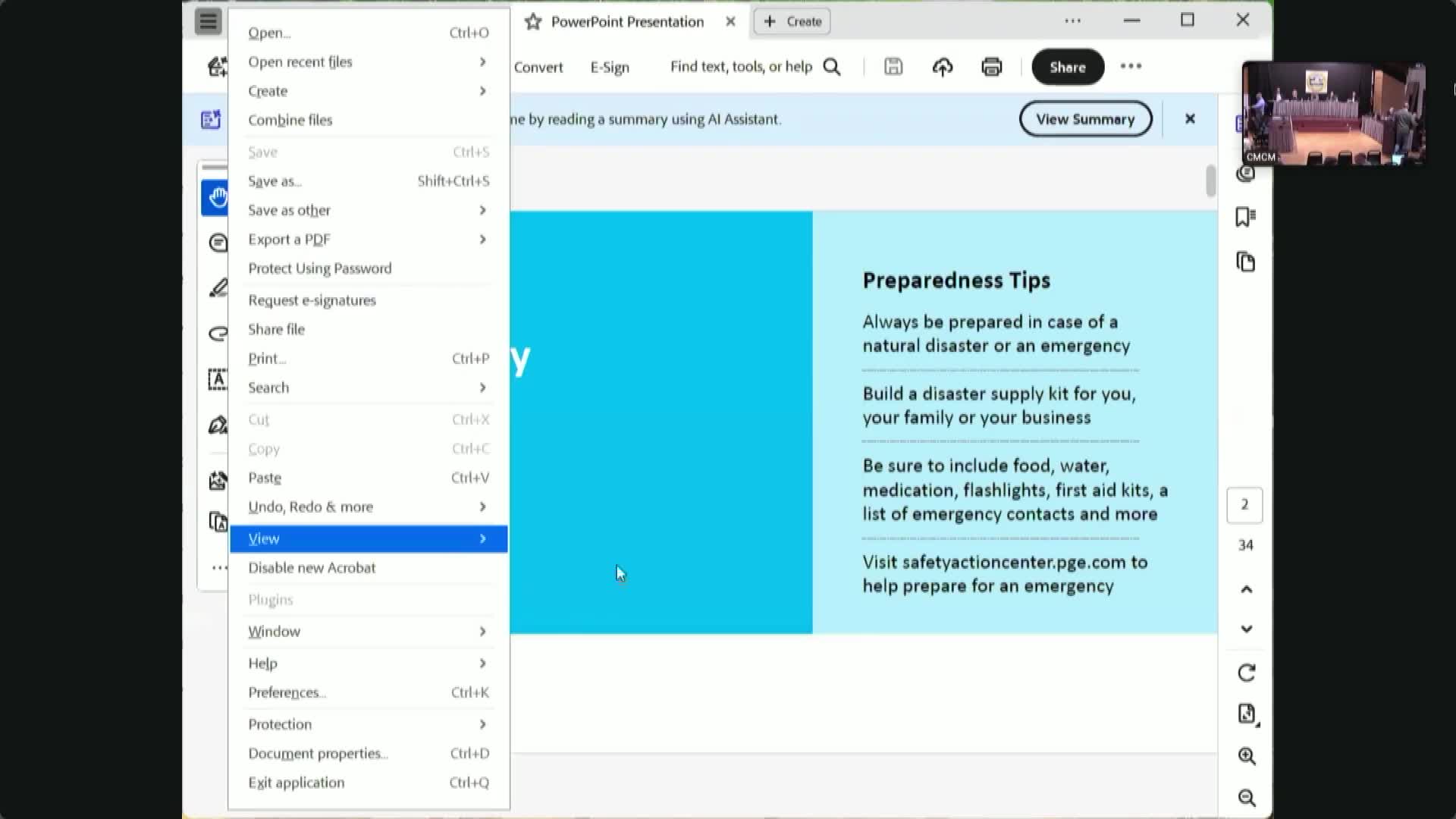PG&E explains enhanced power-line safety settings and vegetation work; reliability numbers mixed
November 06, 2025 | Fairfax Town, Marin County, California
This article was created by AI summarizing key points discussed. AI makes mistakes, so for full details and context, please refer to the video of the full meeting. Please report any errors so we can fix them. Report an error »

Pacific Gas & Electric officials briefed the Fairfax Town Council on Wednesday about the company’s enhanced power‑line safety settings (EPSS), vegetation-management activities and reliability performance in the area, saying major overhead circuits serving Fairfax run through high fire-risk zones and that the utility is investing in outage detection and targeted mitigation.
What the settings do: Mark Van Gorder of PG&E explained that when EPSS is enabled a contact with an energized conductor generally causes the circuit to open in about one‑tenth of a second or less to prevent an ignition. He said the settings are typically enabled during the higher-risk fire season when weather and fuel conditions warrant; customers are notified after an automatic trip but could be given advance notice for larger pre‑planned public-safety power shutoffs (PSPS).
Reliability data and causes: PG&E presented recent outage statistics for circuits serving Fairfax and noted leading causes were vegetation and animals. The company said efforts such as more frequent inspections, improved communications and device deployment to pinpoint outage locations are intended to hasten patrols and restoration.
Customer options and programs: Van Gorder walked residents through PG&E account preferences for outage and emergency notifications (phone, text, email), and he described a generator-ready smart meter pilot for customers on certain circuits. PG&E staff also urged customers to set up accounts and review contact data and described financial assistance programs and community resources for vulnerable customers.
Vegetation management and undergrounding: PG&E representatives described arborist inspections, tree removal and clearance work on company right-of-way. Residents asked about undergrounding lines; company staff said undergrounding decisions and cost recovery are governed by the California Public Utilities Commission, and PG&E has an announced goal to underground thousands of miles in the coming years but that funding and permitting pathways affect timing.
Public questions and concerns: Several residents reported surprise or large billing notices, asked about smart-meter billing conversions and requested more aggressive undergrounding and coordination with Marin Water for fire-flow improvements. PG&E staff advised customers to use the utility’s online account tools to register for alerts and to contact PG&E customer service for bill review and assistance.
Bottom line: PG&E officials emphasized a dual aim — reduce ignitions through EPSS and vegetation work while improving outage response and communications — and said upgrades such as outage‑locator devices and targeted trimming should shorten restoration times when equipment trips automatically.
What the settings do: Mark Van Gorder of PG&E explained that when EPSS is enabled a contact with an energized conductor generally causes the circuit to open in about one‑tenth of a second or less to prevent an ignition. He said the settings are typically enabled during the higher-risk fire season when weather and fuel conditions warrant; customers are notified after an automatic trip but could be given advance notice for larger pre‑planned public-safety power shutoffs (PSPS).
Reliability data and causes: PG&E presented recent outage statistics for circuits serving Fairfax and noted leading causes were vegetation and animals. The company said efforts such as more frequent inspections, improved communications and device deployment to pinpoint outage locations are intended to hasten patrols and restoration.
Customer options and programs: Van Gorder walked residents through PG&E account preferences for outage and emergency notifications (phone, text, email), and he described a generator-ready smart meter pilot for customers on certain circuits. PG&E staff also urged customers to set up accounts and review contact data and described financial assistance programs and community resources for vulnerable customers.
Vegetation management and undergrounding: PG&E representatives described arborist inspections, tree removal and clearance work on company right-of-way. Residents asked about undergrounding lines; company staff said undergrounding decisions and cost recovery are governed by the California Public Utilities Commission, and PG&E has an announced goal to underground thousands of miles in the coming years but that funding and permitting pathways affect timing.
Public questions and concerns: Several residents reported surprise or large billing notices, asked about smart-meter billing conversions and requested more aggressive undergrounding and coordination with Marin Water for fire-flow improvements. PG&E staff advised customers to use the utility’s online account tools to register for alerts and to contact PG&E customer service for bill review and assistance.
Bottom line: PG&E officials emphasized a dual aim — reduce ignitions through EPSS and vegetation work while improving outage response and communications — and said upgrades such as outage‑locator devices and targeted trimming should shorten restoration times when equipment trips automatically.
View full meeting
This article is based on a recent meeting—watch the full video and explore the complete transcript for deeper insights into the discussion.
View full meeting
